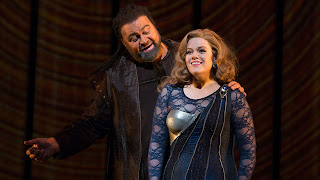On the last day of the 2012-21013 Metropolitan Opera season, we saw the final performance of Gotterdammerung.
There are several reasons for this I think. One, we saw the last performance of the season so we were without Jay Hunter Morris as Siegfried and Eric Owens as Alberich. Eric Owens had been with us since the opening minutes of Das Rheingold and was sorely missed. But especially glaring was the absence of Jay Hunter Morris. As I said his rendition of the Forging Song was the highlight of the entire cycle for me. His replacement, Lars Cleveman, while vocally solid, I found theatrically weak. His constant pacing, motion and ill-defined gestures were incredibly distracting and made him seem uncomfortable on stage. I understand he was going for a youthful vitality but all the excess movement gave him a frenetic, scattered and amateurish stage energy, as if he was nervous not vital.
 Secondly, I found the structure of Götterdämmerung itself problematic. There is so much recap in the piece versus actual new narrative. Almost half and half it felt like. I understand a lot has gone on in the cycle that needs to be mentioned, but the other operas in the cycle camouflaged the expository dialogue in action far more compellingly. Wotan’s riddle game with Mime in Siegfried, for example. Here too often the characters simply told the backstory to the audience. We’ve been all in for over 17 hours now, we know what happened. The Norn weaving women in the Prologue exist only to give back story detail and later Siegfried simply sits by the campfire and tells the audience his own backstory. Perhaps if I had found Lars Cleveman a more compelling Siegfried this would have been less glaring.
Secondly, I found the structure of Götterdämmerung itself problematic. There is so much recap in the piece versus actual new narrative. Almost half and half it felt like. I understand a lot has gone on in the cycle that needs to be mentioned, but the other operas in the cycle camouflaged the expository dialogue in action far more compellingly. Wotan’s riddle game with Mime in Siegfried, for example. Here too often the characters simply told the backstory to the audience. We’ve been all in for over 17 hours now, we know what happened. The Norn weaving women in the Prologue exist only to give back story detail and later Siegfried simply sits by the campfire and tells the audience his own backstory. Perhaps if I had found Lars Cleveman a more compelling Siegfried this would have been less glaring.
 My mild disappointment with Götterdämmerung aside, I still find The Machine a wonderful and compelling stage tool. One set, four operas, constantly and organically shifting from one set piece to another with the music as if born of it.
My mild disappointment with Götterdämmerung aside, I still find The Machine a wonderful and compelling stage tool. One set, four operas, constantly and organically shifting from one set piece to another with the music as if born of it.
– Elizabeth Frayer and Shawn E Milnes
Related Articles:
The Hunchback of the Casino: Rigoletto at the Metropolitan Opera
Wagner and The Machine Infernal: Das Rheingold at the Metropolitan Opera
Mid-Scene Replacements and The Machine Triumphant (Almost): Die Walkure at the Metropolitan Opera








Very interesting story and craft observations, as one would expect from this site and its authors. Their recent articles lend the reader an informed sensibility of this Ring Cycle, and the Met, for a fraction of their 20+ hour investment of time.